To read part one of the series, click here.
By the time 1990 opened, the Royal Studs had operated at the top table under the Queen’s guardianship for the best part of four decades, writes Nancy Sexton. Numerous horses, the majority of them homebreds, had carried the Royal silks with distinction over that period, ranging from the King George winner and Derby runner-up Aureole, subsequently a champion sire at Wolferton Stud, to the dual Classic heroine Dunfermline.
The 1989 season had presented a landmark moment with the victory of Unknown Quantity, a descendant of yearling purchase Amicable, in the $100,000 Arlington Handicap at Arlington Park. Trained by Lord Huntingdon at West Ilsley, the Young Generation gelding had looked progressive without being a Graded stakes winner in waiting when successful in handicap company at Lingfield and Sandown Park.
An audacious plan to take on America was subsequently hatched and he proved up to the challenge, scoring by three lengths under Jorge Velasquez to become the Queen’s first American winner.
Unknown Quantity didn’t win again but the gelding had set the tone for the successful international forays that his trainer was to later pull off with other Royal runners.
At the head of the list was Unknown Quantity’s half-sister Starlet, a daughter of Teenoso whose four-year-old season in 1990 opened with a win at Cagnes-Sur-Mer in France and closed with a second in the Sun Chariot Stakes at Newmarket. Sandwiched in between was an easy Group 2 victory at Frankfurt in Germany, achieved while Starlet was in foal to Sharrood; the resulting foal, dual winner Success Story, later became a black-type producer for the Royal Studs.
Few horses, if any, since then can boast to have won Pattern races in Britain, Germany and Spain.
Enharmonic, an American-bred Diesis colt out of the Busted mare Contralto, was another such animal. Lord Huntingdon had trained Contralto to win the Fenwolf Stakes at Ascot and a decade later, brought her son along steadily, saddling him to win a Listed event on his fourth start at York’s Ebor meeting as a three-year-old in 1990 before sending him on a successful tour of Europe as an older horse.
At four, Enharmonic made two winning trips to Germany, firstly when landing the Group 3 Ostermann Pokal at Cologne and then the Group 3 Oettingen-Rennen at Baden-Baden. Although winless at five, he did pack in a pair of further Group 3 placings in Germany before returning to winning ways at six, when victories in the Diomed Stakes at Epsom – achieved on the 40th anniversary of the Queen’s coronation – and Group 3 Premio Gobierno Vasco at San Sebastien in Spain came his way. Few horses, if any, since then can boast to have won Pattern races in Britain, Germany and Spain.
Similarly, Lord Huntingdon wasn’t afraid to travel Sharp Prod. A precocious colt foaled in 1990, Sharp Prod was more in the mould of his fast sire, the top sprinter Sharpo, although his dam, Gentle Persuasion, had been forward enough to run fourth in the Princess Margaret Stakes despite being a daughter of stamina influence Bustino.
Sharp Prod was out early in 1992 and proceeded to rack up five consecutive victories at home and on the continent, crowned by the Listed Criterium de Bequet at Bordeaux and Group 2 Moet & Chandon-Rennen at Baden-Baden.
This likeable colt was on his travels again at three, when trips to Munich and Longchamp yielded wins in a pair of Listed events, and again the following year, when the highlight of a busy season was a victory in the Group 3 Holsten Trophy at Hamburg. Ultimately, Sharp Prod won nine races, six of them at stakes level across Europe.
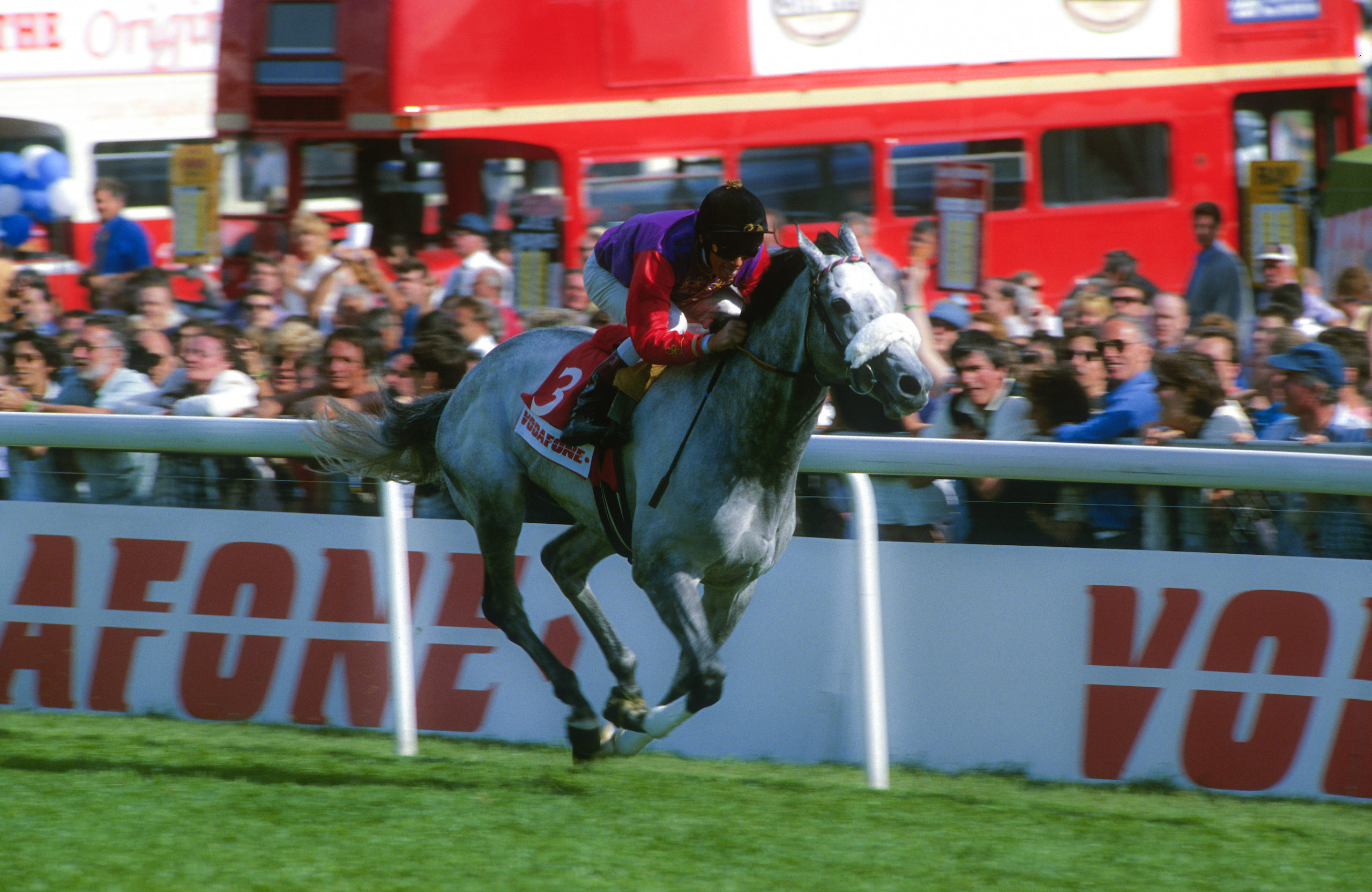
Arabian Story: ran well in the 1997 Melbourne Cup. Photo – George Selwyn
Yet Lord Huntingdon was to travel further afield with the popular grey Arabian Story. Fittingly a close relation to Unknown Quantity, the Sharrood gelding initially hit prominence when running away with the 1996 Moet & Chandon Silver Magnum at Epsom under Luis Urbano-Grajales. He continued to improve thereafter, bagging the Steventon Stakes at Newbury and running Posidonas to a short-head in an Arc trial, with Swain in behind, prior to an assault on the Melbourne Cup. The first – and to date only – Royal runner in the iconic Australian event, Arabian Story wasn’t disgraced in sixth under Frankie Dettori behind Might And Power. He was beaten less than four lengths, and as Dettori outlined to the press, the result might have been closer had the horse not missed the start.
“He got upset in the stalls and missed the start by a length,” he said at the time. “He relaxed well and was moving into the race at the 800 metres. He got to the line well.”
“characterful individual”
However, the horse with which the Queen is arguably most closely associated during this era is not one of those admirable international campaigners but Phantom Gold, another member of the Amicable clan foaled in 1992.
From the first crop of Machiavellian, Phantom Gold had shaped like a potentially smart filly for Lord Huntingdon when winning her second start, a maiden at Sandown, as a two-year-old, and it all came together the following June when under Frankie Dettori, she held on for a popular win in the Ribblesdale Stakes. In the process, she emulated her granddam Expansive, a daughter of Amicable who had been successful 16 years before.
Phantom Gold is remembered by Timeform as a “characterful individual”, one who was prone to swishing her tail and hanging left when under pressure. However, she went on to embellish her season with a win in the St Simon Stakes at Newbury and was kept in training at four, when a victory in the Geoffrey Freer Stakes while in foal to Cadeaux Genereux justified connections’ perseverance.
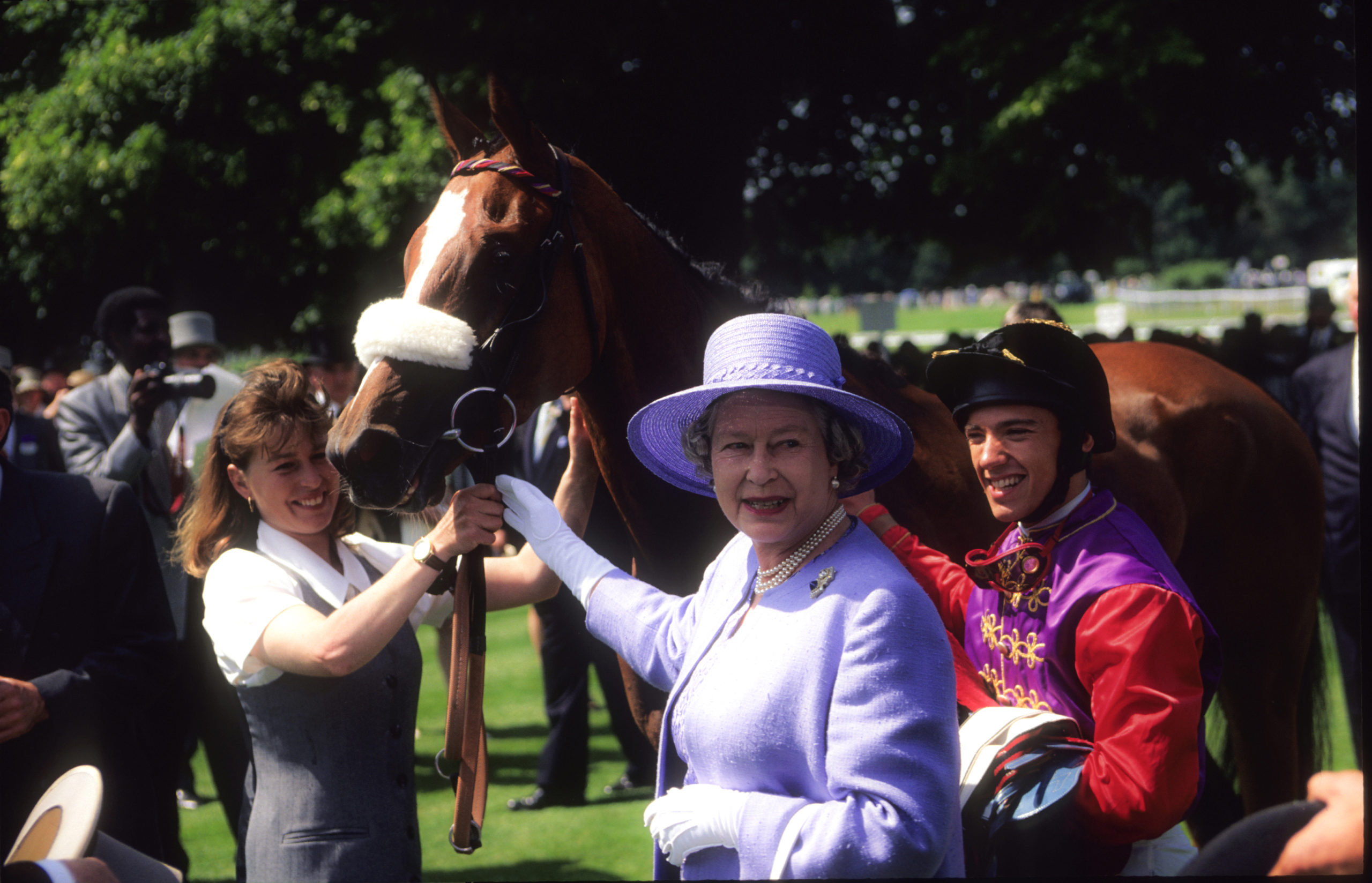
The Queen pictured with Phantom Gold after winning the Ribblesdale Stakes. Photo – George Selwyn
Phantom Gold’s career had done much to bring her branch of the Amicable family into sharper focus. Yet her achievements marked only the start of a fruitful decade for her dam, Trying For Gold.
Her 1994 filly by the Royal Studs stallion Shirley Heights, Tempting Prospect, ran second in a Newbury Oaks Trial while her full-sister Fictitious was handled by Sir Michael Stoute to win the Listed Hoppings Stakes at Chepstow.
Fictitious was later sent to America, where she won the Grade 3 De La Rose Handicap for Christophe Clement.
The popular staying handicapper Whitechapel, meanwhile, carried the Royal colours to victory in no fewer than 11 races. He was a firm presence throughout the decade, which closed with two members of Roger Charlton’s Beckhampton stable, Fairy Godmother and Holly Blue, landing Listed races within weeks of each other in June 1999; Fairy Godmother won the Ballymacoll Stud Fillies Stakes while Holly Blue landed the Fern Hill Fillies Rated Stakes at Royal Ascot.
Each remained in training for 2000 but neither could match the rapid progression of Fairy Godmother’s older half-brother Blueprint. A sixth generation Royal homebred as a descendant of Feola, the Generous colt had initially been trained by Lord Huntingdon, for whom he had won the 1998 Melrose Handicap at York.
Lord Huntingdon retired from training at the end of that year and the horses dispersed to different trainers, including Richard Hannon and Sir Michael Stoute, both then new additions to the roster.
Blueprint headed to the latter’s Freemason Lodge Stables in Newmarket – fittingly once base of the Queen’s Classic trainer Captain Sir Cecil Boyd- Rochfort. The colt’s physique and breeding lent confidence to the idea that he would improve with a winter on his back, and so it proved. Partnered by the top American jockey Gary Stevens, then attached to the Stoute yard, Blueprint won the Duke of Edinburgh Stakes at Royal Ascot on his second start at four before making the anticipated successful leap into black-type company with a win in the Fred Archer Stakes at Newmarket.
For Stevens, who had made the move to Britain that summer to refresh his jaded enthusiasm, the Royal Ascot victory was certainly one to savour.
“I’ve ridden champions in $5 million races,” he told the press following the race. “But to ride a winner for the Queen, at her meeting, and to meet her was the most exciting and happiest moment of my career. And the silks I wore; they were old ones and when I put them on, I thought of all the great jockeys who had worn them before.”
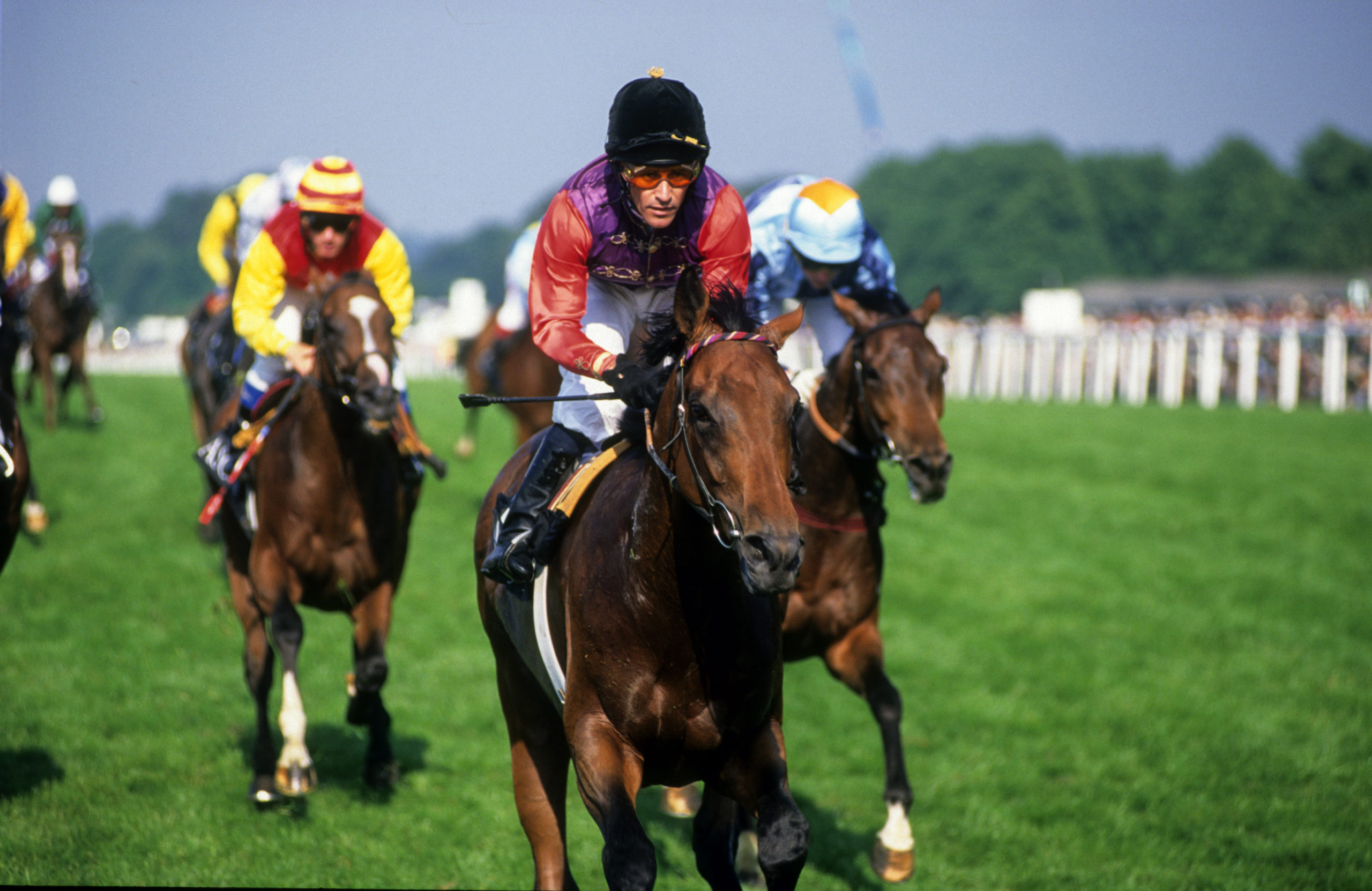
“The silks were old ones and when I put them on, I thought of all the great jockeys who had worn them before” – Gary Stevens steers Blueprint to success in the 1999 Duke of Edinburgh Stakes. Photo – George Selwyn
2000s
Stevens was to put his knowledge of Blueprint to good use later on in the horse’s career when steering him to victory in the Grade 2 San Luis Rey Handicap at Santa Anita. By that stage, the horse was under the ownership of Fog City Stable, having been sold to continue his career in the US following a winning reappearance for the Queen in the Jockey Club Stakes at Newmarket. An admirable colt who won nine races in all, he went on to stand as a jumps sire with some success in Britain and Ireland.
Blueprint helped open the decade on a positive footing but sadness was to come in September 2001 with the death of the Queen’s long-term racing manager Lord Carnarvon. An enthusiastic owner-breeder himself whose colours had been carried to high-profile success by the likes of Little Wolf, Smuggler, Lyric Fantasy, Niche and Lemon Souffle, he left a major void within the Royal operation that came to be filled by his son-in-law John Warren.
Blueprint’s success had added further lustre to the Highclere branch of the Feola family that was to be subsequently enhanced by Banknote, bred out of the Queen Mother’s Bustino mare Brand.
Plagued by a series of problems while in training, Brand never made it to the track, but it is said that stud manager Sir Michael Oswald believed that she might be worth breeding from and thankfully so, given the subsequent achievements of her 2002 Zafonic colt foal, Banknote. Sent to Andrew Balding, he progressed from classy handicapper to Group 3-winning miler during a lengthy 27-start career before retiring to stud in Turkey.
The exploits of Right Approach, meanwhile, paid further tribute to the line descending from Highclere’s half-sister Christchurch. Another by Machiavellian, Right Approach was shadowed by high expectations from the time he made a winning juvenile debut for Sir Michael Stoute at Newmarket.
Hopes that he would develop into a Derby colt failed to materialise but with patient handling, he did indeed go on to hold his own at the top level as an older horse, most notably when running second to Dubai Destination in the Queen Anne Stakes at Royal Ascot.
He was subsequently sold to race on internationally with South African trainer Mike de Kock, for whom he won the 2004 Dubai Duty Free. As those results showed, the Feola line continued to remain integral to the Royal Studs.
However, it was one of the Queen’s most remarkable families that also helped drive the Royal Studs forward during this era. Homebred Example, by Exbury out of Amicable, had been one of the most successful fillies of the 1971 season, winning the Park Hill Stakes and Prix de Royallieu for Ian Balding. Sadly, Example died foaling her first foal, Pas De Deux, and when that filly showed limited ability, there must have been doubt over the idea of Example’s legacy taking hold. Yet take hold it did, with Pas De Deux becoming so influential that today the Nijinsky mare features as the ancestress of almost 20 stakes winners.
A chief cog in that development was Starlet
A chief cog in that development was Pas De Deux’s talented daughter Starlet. The Queen had been restricted for some time in her use of Irish-based stallions but by the late 1990s that avenue had thankfully opened up; Starlet was sent to Sadler’s Wells and the resulting foal, Interlude, won the Prix de Pomone at Deauville for Sir Michael Stoute having previously run an unlucky third in the Ribblesdale Stakes at Royal Ascot.
Sadly, Interlude died young without producing a foal, something which undoubtedly made the achievements of her older half-sister Success Story all the more sweeter. Success Story was the Sharrood filly that Starlet was carrying at the time of her win in a German Group 2 and while she didn’t show the talent of her dam on the track, went on to become an important producer, notably as the dam of Film Script, a daughter of Unfuwain trained by Roger Charlton to win the Lingfield Oaks Trial and Golden Daffodil Stakes. In turn, she went on to foal the high-class two-year-old Free Agent, winner of the 2008 Chesham Stakes for Richard Hannon.
Not to be outdone was the branch belonging to Pas De Deux’s Northern Baby daughter Trying For Gold. As anticipated, Phantom Gold became a major asset to the stud. A regular visitor to Sadler’s Wells, she threw two quite different fillies in Flight Of Fancy, a slightly unlucky runner-up in the 2001 Oaks, and Golden Stream, a proper 7f performer who won the Listed Eternal and October Stakes. What made the latter interesting was the speed she showed for one by Sadler’s Wells out of a proven middle-distance runner.
Flight Of Fancy, on the other hand, had spent a lot of that winter as ante-post favourite for the Oaks following a highly impressive Salisbury maiden win. An educational fourth in the Musidora Stakes did little to dampen enthusiasm and in the event, Flight Of Fancy overcame a challenging passage to get within striking distance of the winner Imagine. However, the filly had hung sharply left while doing so and it later emerged that she had suffered a hairline fracture to her pelvis.
“I think she would have won if she hadn’t hurt herself,” Stoute recalled in Her Majesty’s Pleasure by Julian Muscat.
“She hung very badly after she injured her pelvis and could never race again.”
Both Flight Of Fancy and Golden Stream have since become important producers but as with any major operation, the stud has also continued to benefit from the influx of new blood.
Kissing Gate, a daughter of Easy Goer purchased as a yearling, was one such mare as the dam of Listed winner Forward Move as was Marl, a daughter of Lycius who threw Sceptre Stakes winner Medley and the stakes-placed Green Line. Another purchase, the well-related Montjeu filly Enticement, also won the Montrose Stakes as a two-year-old in 2008 and returned to Newmarket the following year to capture another Listed event.
2010s to present
The first year of the 2010s was not the most productive of the Queen’s rich history in racing, strictly in terms of black-type success on the track, as there were only the two Listed winners in the royal colours, both trained by Richard Hannon snr – Free Agent in the John Smith’s Silver Cup at York and Royal Exchange in the Stonehenge Stakes at Salisbury, writes Martin Stevens.
There was also a rather frustrating near-miss at Royal Ascot that season as Quadrille, an admirably consistent son of Danehill Dancer out of Fictitious also in the care of Hannon snr, was just reeled in by Afsare in a finish of bobbing heads to the Hampton Court Stakes.
However, it turned out to be the calm before the storm, as that autumn the two-year-old Carlton House was sent out by Sir Michael Stoute to win a typically competitive Newbury back-end maiden by nine lengths. It took only a shake of the reins from Ryan Moore for the handsome bay, bred by Darley, to surge clear in the most impressive fashion.
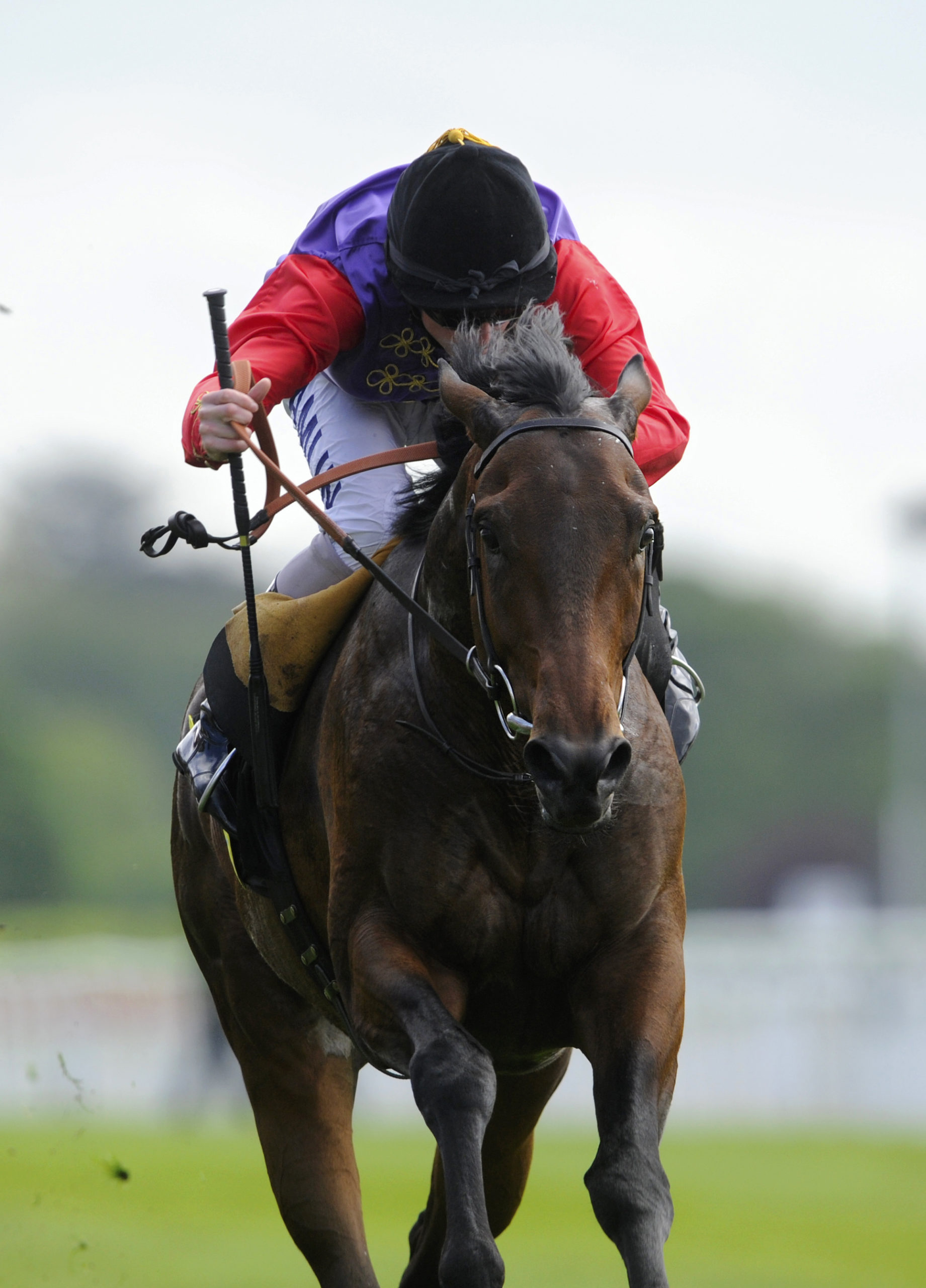
Carlton House: ran a fine third in the Derby. Photo – George Selwyn
Excitement grew over the winter that the colt by Street Cry – whose son Street Sense had won the Kentucky Derby when the Queen fulfilled her long-held ambition of attending the ‘run for the roses’ in 2007 – might be the one to finally win the Derby for the monarch, and it reached fever pitch when he showed abundant class to gain an emphatic victory over Racing Post Trophy second Seville in the Dante on his three-year-old bow.
Carlton House’s promotion to Derby favourite created a huge buzz, not only in racing circles but among the wider public too, and it must have provided a lively talking point when the Queen and the Duke of Edinburgh embarked on their historic state visit to Ireland, which took in trips to the Irish National Stud, Gilltown Stud and Coolmore, just a few days later.
Carlton House maintained his position at the head of the Derby betting in spite of a late fitness scare, his price no doubt a reflection of the intense interest in the Queen potentially celebrating a first winner of the race. It wasn’t quite to be on the big day at Epsom, where newlyweds the Duke and Duchess of Cambridge were in attendance to help cheer on the colt, but he finished a highly creditable third behind the fast-finishing Pour Moi – partnered by a young Mickael Barzalona, who famously celebrated before the winning line – and the more prominently ridden Treasure Beach, with a wide trip and a lost shoe hindering his effort.
He became the Queen’s first horse in training in Australia
Carlton House ran fourth to Treasure Beach in the Irish Derby, narrowly beaten once again by stronger staying rivals, and the decision was taken to drop him in trip at four, when he won the Brigadier Gerard and took second in the Prince Of Wales’s Stakes. He was later sent to Gai Waterhouse to become the Queen’s first horse in training in Australia and finished a short-head second in the Ranvet Stakes and third, behind two true top-notchers in Dundeel and Sacred Falls, in the Queen Elizabeth Stakes.
Carlton House was not the only black- type winner owned by the Queen in 2011. Tactician, a gelding from the first crop of the Royal Studs stallion Motivator out of Tempting Prospect, a winning Shirley Heights half-sister to Quadrille’s dam Fictitious, made it back-to-back Royal winners of the John Smith’s Silver Cup, while Set To Music, a Danehill Dancer filly bred by the Aga Khan from a mare related to Zarkava, rose through the handicap ranks to win the Galtres Stakes. Both were trained by Michael Bell.
In the next couple of years another filly who was the result of the Aga Khan making a number of mares available to the Queen as an 80th birthday present caused a hullabaloo that eclipsed even the excitement generated by Carlton House’s Derby challenge.
Estimate, a half-sister to Group 1 winners Ebadiyla, Edabiya and Enzeli by the outstanding German sire Monsun, and a one-time stablemate of Carlton House at Stoute’s Freemason Lodge, provided the Queen with a Royal Ascot winner in her Diamond Jubilee year thanks to her bloodless five-length victory in the Queen’s Vase at three.
Estimate ran third to Wild Coco in both the Lillie Langtry Stakes and Park Hill Stakes later in 2012 and improved over the winter to win the Sagaro Stakes and to emulate her half-brother Enzeli’s success in the Gold Cup at four. It was the Queen’s first success in the race – the first for any reigning monarch in its 207-year history, in fact – and the image of her celebrating the victory and affectionately greeting the filly in the winner’s enclosure are still fondly remembered by racing fans today.
Estimate was somewhat inconsistent later in her career – Stoute remarked that although her resolve was unimpeachable, she was very energetic and had a tendency to be “a little bit narky” – but she added the Doncaster Cup to her resumé at four and promises to be an important addition to the royal broodmare band. Two of her early progeny, the Dubawi geldings Calculation and Evaluation, have won multiple times and achieved high ratings, and she has a two-year-old filly by Siyouni and a yearling colt by Lope De Vega to look forward to.
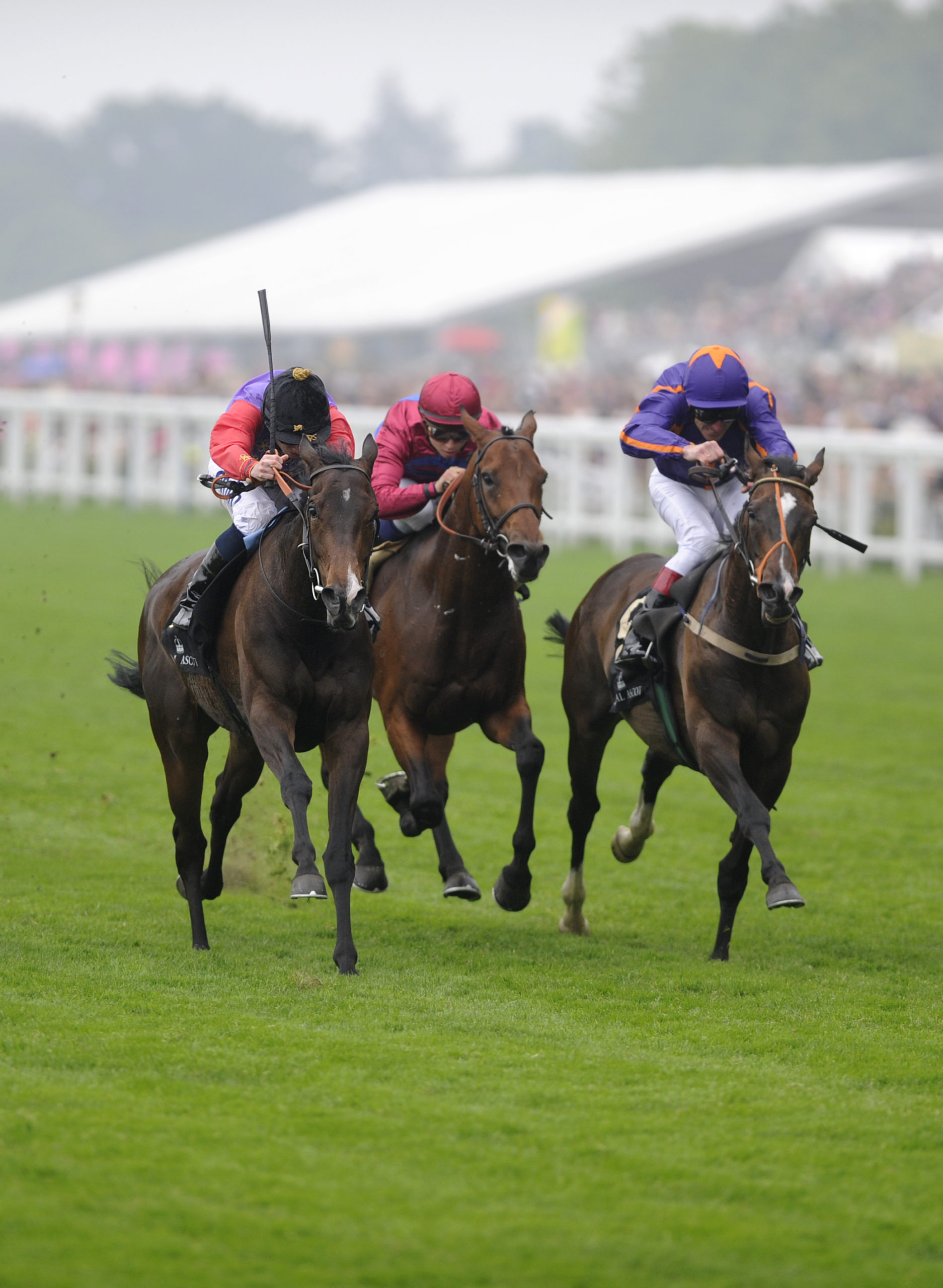
Estimate was a popular winner of the Ascot Gold Cup. Photo – George Selwyn
The Queen’s familiarity with the unpredictable nature of horses, and the knowledge that in racing those two impostors triumph and disaster must be treated the same, proved invaluable not long after Estimate’s Gold Cup heroics.
Later in 2013 the brilliant Dubawi colt Al Kazeem was bought to stand at the Royal Studs, and syndicated among some of the world’s leading breeders, only for the horse to prove subfertile and be returned into training the following spring.
“The Queen was particularly disappointed by the news but made the comment that, sadly, horses will always have the last word,” noted her racing manager John Warren at the time.
As it turned out, another stallion prospect emerged soon after in the shape of Recorder, a Royal Studs product by Galileo out of the Albany Stakes and Cherry Hinton Stakes winner Memory. He looked a star when winning a Newmarket maiden and the Acomb Stakes at two for William Haggas, but was prevented from running at three or older due to injury.
The shrewd decision was made to send this high-class, precocious talent with an impeccable pedigree to Haras de Montfort et Preaux to take advantage of the buoyant French bloodstock market. It is still early days in his second career but his second crop of two-year-olds has yielded the Queen›s recent Nottingham maiden winner Garner.
The exciting colt is out of a placed Oasis Dream half-sister to My Kingdom Of Fife, who became a rare Group 1 winner bred by the person after whom the race was named when taking the 2011 Queen Elizabeth Stakes at Randwick.
Memory has certainly enhanced the Royal Studs broodmare band, with all of her first three foals becoming black-type winners. Recorder, her debut offspring, was followed by Call To Mind, another son of Galileo who won the Belmont Gold Cup and ran second in the Yorkshire Cup, and Learn By Heart, a son of Frankel who finished second in the Ascendant Stakes and later became a star in Scandinavia. The mare has a two-year-old filly by Dubawi, named Reminder, and a yearling filly by Night Of Thunder in the pipeline.
Like London buses, another appealing stallion prospect arrived soon after Recorder. Dartmouth, a son of Galileo and Blue Wind Stakes winner Galatee, another mare loaned by Darley to the Royal Studs, established himself a high-class handicapper at three, when he was sent out by Sir Michael Stoute to win valuable heats at Ascot and Glorious Goodwood, and later rose to the cream of the middle- distance ranks.
He took the John Porter Stakes, Ormonde Stakes and Hardwicke Stakes and finished placed in the King George VI and Queen Elizabeth Stakes and Canadian International at four, and won the Yorkshire Cup and was beaten just a nose into second in the Lonsdale Cup at five.
Winners at both Royal Ascot and the Cheltenham Festival
Dartmouth was retired to Shade Oak Stud in Shropshire at the end of his racing career and has been well supported by British-based National Hunt breeders in pursuit of an attractive horse with plenty of stamina and a dash of serious class. His first crop of three-year-olds will go under the hammer at this summer’s store sales.
The Queen has sent a number of jumps mares to Dartmouth, and it must give her immense pleasure to honour the late Queen Mother’s passion for National Hunt racing by continuing the royal patronage of the winter game. Close Touch, Forth Bridge and Sunshade all bore the monarch’s colours to win black- type hurdle races in the 2010s, when the small string of jumpers was expertly overseen by Sir Michael Oswald, a former manager of the Royal Studs and the Queen Mother’s jumps interests, who died last year after half a century of devoted service to the royal family.
An amusing aside related to jump racing is that being a pedigree buff, the Queen may have raised a wry smile when her Unfuwain mare Film Script achieved the rare distinction of producing winners at both Royal Ascot and the Cheltenham Festival, with Domesday Book scoring in the Fulke Walwyn Kim Muir Challenge Cup for his new owner Jim Humberstone in 2017, nine years after Free Agent had taken the Chesham Stakes.
Dartmouth was part of a flurry of stakes success for the Queen in the second half of the 2010s, with both the longer established Royal Studs families and newer injections of blood producing some fine results.
In 2015, Peacock, a son of Paco Boy and Rainbow’s Edge, a winning Rainbow Quest half-sister to Free Agent and Domesday Book, won the Fairway Stakes for Richard Hannon jnr, while the Haggas- trained Light Music, a daughter of Elusive Quality and Medley, scored in the Radley Stakes.
In the following year Diploma, a daughter of Dubawi and Enticement, struck in the Lyric Fillies’ Stakes for Stoute, and in 2017 Fabricate, by Makfi out of Oaks runner-up Flight Of Fancy, notched the first of his back-to-back victories in the Winter Hill Stakes for Bell, while Daphne, a daughter of Duke Of Marmalade and Flight Of Fancy’s useful half-sister Daring Aim, struck in the River Eden Fillies’ Stakes for Haggas.
Call To Mind and Fabricate were the headline acts for the Queen in 2018, while Listed successes for the Stoute-trained Sextant, a son of Sea The Stars and Hypoteneuse, a winning full-sister to Flight Of Fancy, and the Haggas-trained Magnetic Charm, an Exceed And Excel half-sister to the high-class Usherette out of a Darley-owned mare, were among the highlights of 2019.
Careful cultivation of key families through judicious matings and selective culls, combined with occasional high- class additions to the broodmare band, have continued to pay off in the early years of the 2020s.
Tactical, a son of Toronado, was sent out by Andrew Balding to win the Windsor Castle Stakes and July Stakes at two and the European Handicap at three in 2021. He provides further evidence of the efforts made to keep reinvigorating bloodlines, as he is out of the Makfi mare Make Fast, who entered the Queen’s ownership as part of a filly exchange with Qatar Racing and finished second to fellow royal colour- bearer Light Music in the Radley Stakes in her racing pomp.
King’s Lynn and Light Refrain have been two more unusually speedy products of the Royal Studs breeding programme in recent years. King’s Lynn, sent out by Balding to win a valuable sales race at two and a pair of Listed sprints at four, put himself in the picture for Royal Ascot with victory in the Group 2 Temple Stakes at Haydock on May 21. He is by Cable Bay out of Kinematic, a sharp and speedy filly who certainly resembled her sire, the five-furlong star Kyllachy, more than her dam, the Lupe Stakes second Spinning Top. That mare was by Alzao out of Zenith, who in turn was a winning daughter of Shirley Heights and Soprano, a dual Listed winner and game third to Al Bahathri in the Coronation Stakes.
Light Refrain, meanwhile, has made a name for herself as one of the fastest progeny of Frankel, who has turned out to be a rich source of stamina more often than not. The four-year-old filly, sent out by Haggas to win the Kilvington Stakes and Summer Stakes last summer, is the first foal out of Light Music.
Her year-younger half-sister Distant Light, by Fastnet Rock, could also develop into a useful performer for the Queen, judging by her two-length victory in a Lingfield fillies’ novice stakes for Balding in April.
He could provide the Queen with a Royal Ascot winner in the 70th year of her reign
In spite of that run of sprinters, the focus of the Royal Studs remains on trying to produce Classic performers for the Queen, and especially a colt who could complete her nap hand of British Classics by winning the Derby.
Hopes were high that Reach For The Moon, a four-length winner of the Solario Stakes and runner-up in the Champagne Stakes last year, might do the job in this Platinum Jubilee year, but he failed to recover from an injury in time to compete in his intended Derby trial, the Dante Stakes, and the big race at Epsom itself.
Reach For The Moon contested the Heron Stakes at Sandown on his delayed reappearance at three and in chasing home My Prospero, ran a race that gave hope that he could prove the Queen with a Royal Ascot winner in the 70th year of her reign; not bad compensation for missing the Derby.
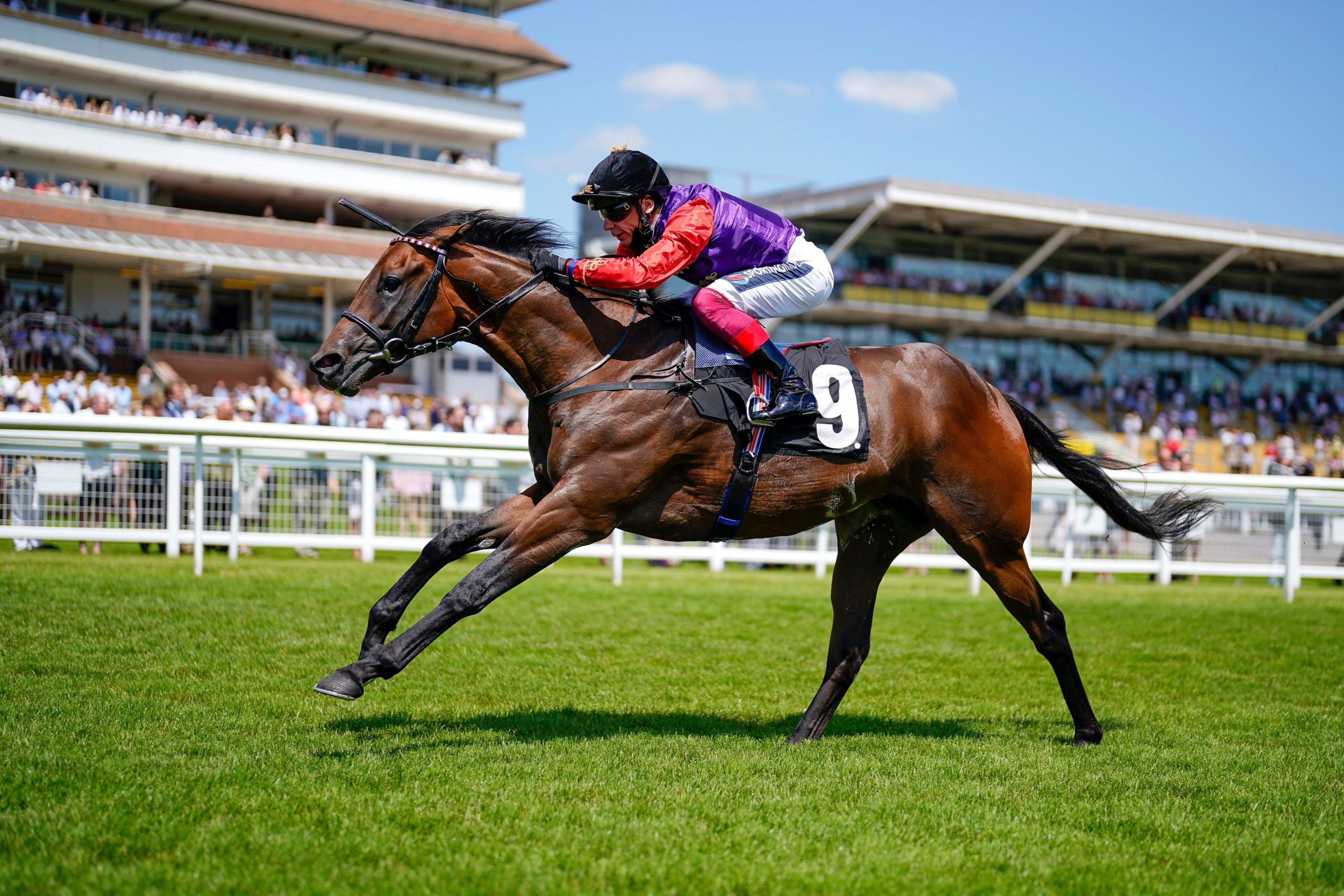
Reach For The Moon: remains an exciting three-year-old prospect. Photo – PA
Reach For The Moon is a most fitting standard-bearer for the Royal Studs in this momentous year, as he hails from a family that the Queen has nurtured for most of her reign. He is one of three black-type horses out of Golden Stream, a Listed-winning full-sister to Flight Of Fancy, whose fourth dam was the Nell Gwyn winner Amicable. Her purchase as a yearling in 1961 was detailed when we began this overview of the Queen’s time in racing in the last issue.
Throughout all those years, the Queen has remained a steadfast supporter of racing, and in return her horses and their human connections have provided her with an enjoyable diversion from the affairs of state.
Her Majesty, who has been Patron of the Thoroughbred Breeders’ Association since 1954, was a most worthy inductee into the QIPCO British Champions Series Racing Hall of Fame last year, in honour of her unswerving and lifelong dedication to the sport. The news prompted her racing manager John Warren to pay a tribute that neatly encapsulates her endeavours.
“The Queen’s contribution to racing and breeding derives from a lifelong commitment,” he said. “Her love of horses and their welfare comes with a deep understanding of what is required to breed, rear, train and ride a thoroughbred.
“Her Majesty’s fascination is unwavering and her pleasure derives from all of her horses – always accepting the outcome of their ability so gracefully.”



